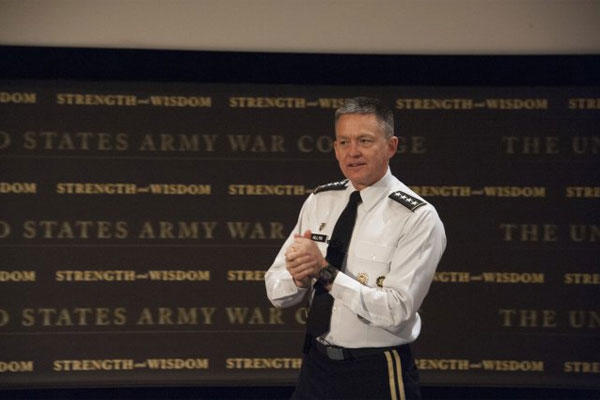In the midst of massive troop cuts, the Army's vice chief of staff today stressed that the service's battlefield network be designed to work alongside technology used by allied nations.
"We cannot afford to, nor will we, work alone across this increasingly unstable globe," Gen. Daniel Allyn told an audience at an Association of the United States Army symposium on the Army Network.
The United States and its allies "live in a world where information flows freely across the globe, connecting like-minded criminals and violent extremists who are intent on undermining our way of life. ... The Army operating concept recognizes that our Army will face networked enemies in the future."
Allyn's comments came as the Army is cutting 40,000 soldiers from the ranks, reducing the active force down to 450,000 a year earlier than planned.
"Our Army is budgeted as we speak at an active force of 450,000 soldiers ... that's the funding that is available for our Army," Allyn said. "As a result we must reduce our active force by 40,000. These aren't cuts the Army wants to make. These are cuts required by the budget and by the environment in which we operate."
The Army's sophisticated network technology continues to be the service's number-one modernization effort. To Allyn, the effort is even more critical now.
"No set of equipment compensates for a smaller force capacity, but if you have a smaller force, it must be effectively networked, it must have situational understanding and it must be able to make critical decisions ahead of enemy's and adversary's decisions," he said.
"It's essential to the Army of the future that we continue to develop and field advanced processing and analytic fusion tools, decision aids and simplified networks that are resistant to cyberattacks. I guarantee you our enemies are doing just this."
Allyn also stressed that allied forces must be able to use this network technology alongside the United States to effectively counter threats such as Russia, which continues to mass forces on Ukraine's border.
The U.S. and U.K. militaries have recently increased their level of cooperation, participating in more joint exercises than ever before.
Units from the 173rd Airborne have operated in 22 countries this year alone as a part of Operation Atlantic Resolve with 30 different nations, Allyn said.
"We are tackling these interoperability issues from the strategic, the operational and down to the tactical level," he said.
"You have got to integrate that approach at the outset because if we don't we will find ourselves in a situation like we had in a force-on-force in Germany earlier this year where a tactical unit of one of our allied nations attempted to call for fire and because of interoperability challenges, by the time that call made it through the system ... our friendly forces had gotten tired of waiting and proceeded to attack without fires, and then we had a fratricide scenario. So that is what happens when we don't get it right. We have got to practice it at every echelon as we work through this."
As a short-term fix, the Army has stood up what it calls Expeditionary Digital Support Liaison Teams. These are small teams equipped with U.S.-based Army battle command systems that embed with a partner unit and provide them with the technology and help interpret information for unit leaders to create a common operating picture.
-- Matthew Cox can be reached at matthew.cox@military.com































